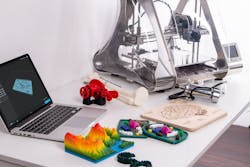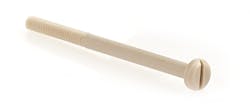3D printing is often referred to as one of the most revolutionary technologies of the 21st Century because it has the potential to disrupt nearly every industry. This is especially true for PEEK plastic, also known as polyether ether ketone. PEEK is one of the most highly rated polymers due to its mechanical strength and superior resistance to heat, water and chemicals. The material properties make it an ideal choice for products in demanding applications in hot temperatures such as bearings and pumps. The resistance to heat makes the material appeal to design engineers, but also poses several challenges when it comes to 3D printing.
Challenges of 3D Printing PEEK
PEEK is often used in the medical industry, but it has a long way to go before it can be used for precision engineering components, particularly products with tight tolerances such as machine screws The main challenge of 3D printing PEEK products is that the print environment has to reach 343°C before the plastic can melt in order to be reformed inside the printer. It then has to cool before it can solidify, and it shrinks as it cools.
Shrinking during the cooling process means that a PEEK machine screw would shrink to a smaller size, making the thread ineffective.
There are multiple companies that have developed 3D printers specifically for melting PEEK into an easily workable format. They have been developing methods to minimize vibrations which can potentially cause inconsistencies in the print. They are currently working on ways to solidify PEEK plastic without it shrinking.
Could 3D Printed PEEK Change Engineering?
Once manufacturers of 3D printers develop technology that can print intricate PEEK products with precision and speed, it will disrupt many industries and impact the future of thermoplastic engineering. The initial set up cost might be high, but no more expensive than CNC equipment. Plus, with the reduction in waste, the running cost compared to machining could be a more cost-effective option. Therefore, PEEK has the potential to transform production facilities, especially as 3D printers become cheaper, faster, and more reliable. It could turn manufacturing into an automated “made to order” process whereby a customer can type their requirements into a website and send their order to a 3D printer in the factory, which automatically completes the order. Automated 3D printers could form the basis of Industry 5.0 factories where smart technology could automatically print bespoke engineering components.
3D printers have already helped to reduce the lead times in traditional industries such as the rail industry. For example, polyamide components such as grab handles and armrests on trains were previously difficult to source with a long lead time. Now with 3D printing, lead times are reduced from 10 weeks to three, which reduced the cost and changed the supply chain. Therefore, once a manufacturer has found a way to 3D print PEEK plastic with a high level of precision, there will be a breakthrough which has the potential to disrupt nearly every industry because thermoplastic such as PEEK has many advantageous material properties.
It is highly resistant to heat, chemicals and hydrolysis (hot water and steam), which makes it suitable for more applications than standard plastics. For example, 3D-printed PEEK is already very popular with manufacturers in the medical industry for making specialist biocompatible parts which are used as implants and devices in the skull and in the hand. There are companies such as Vestakeep who make highly biocompatible, biostable, and x-ray transparent implants, which are said to make the operation and follow-up appointments easier for the patient and the surgeon.
How Do 3D-printed PEEK Products Compare?
One of the main advantages that 3D printing PEEK has over traditional subtractive methods, such as CNC machining, is that it does not involve machining or cutting away sections of the material. Therefore, additive manufacturing is said to be more environmentally friendly because of the lean production process. Machining can result in up to 90% of the original block of material being wasted in some cases.
Shrinkage that occurs during the 3D printing process affects the GD&T of finished parts. Some manufacturers are designing enclosed printers that can control the internal temperature, but for now machining may be the better solution for precision screws.
The main disadvantage of 3D printing PEEK components is that machining parts is much more accurate. Despite 3D printing being able to achieve complex geometries, shrinkage negatively affects the dimensions of the end product. Therefore, PEEK has a long way to go before it becomes the chosen manufacturing method for precision components such as grub screws. For 3D printing to become more accurate often involves slowing the print, which currently makes machining the better choice on larger production scales. Injection molding PEEK is even faster and therefore one of the more popular options for manufacturing high volumes of parts. It also generates less waste than machining, and it is usually more accurate than 3D printing PEEK products. However, the cost and lead-time for tooling will have to considered, which would give the customizable abilities of 3D printing.
While 3D printing PEEK has some work to make up in the precision screw market, it is still disrupting the medical industry with implants. Perhaps 3D printing will take over some day, but these different applications show that it’s another viable tool in the box for engineers to use.
Zara Crowther is the content marketing coordinator at Accu, one of the world’s leading precision engineering component suppliers.



